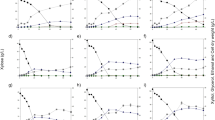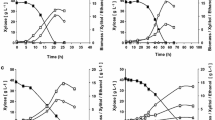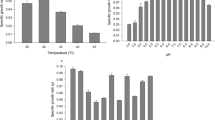Summary
The ability of a Candida shehatae and a Pachysolen tannophilus strain to ferment D-xylose to ethanol was evaluated in defined and complex media under different levels of aeration. Aeration enhanced the ethanol productivity of both yeasts considerably. C. shehatae maintained a higher fermentation rate and ethanol yield than P. tannophilus over a wide range of aeration levels. Ethanol production by C. shehatae commenced during the early stage of the fermentation, whereas with P. tannophilus there was a considerable lag between the initiation of growth and ethanol production. Both yeasts produced appreciable quantities of xylitol late in the fermentation. P. tannophilus failed to grow under anoxic conditions, producing a maximum of only 0.5 g · l-1 ethanol. In comparison, C. shehatae exhibited limited growth in anoxic cultures, and produced ethanol much more rapidly. Under the condition of aeration where C. shehatae exhibited the highest ethanol productivity, the fermentation parameters were: maximum specific growth rate, 0.15 h-1; maximum volumetric and specific rates of ethanol production, 0.7 g (l · h)-1 and 0.34 g ethanol (g cells · h)-1 respectively; ethanol yield, 0.36 g (g xylose)-1. The best values obtained with P. tannophilus were: maximum specific growth rate, 0.14 h-1; maximum volumetric and specific rates of ethanol production, 0.22 g (l · h)-1 and 0.07 h-1 respectively; ethanol yield coefficient, 0.28. Because of its higher ethanol productivity at various levels of aeration, C. shehatae has a greater potential for ethanol production from xylose than P. tannophilus.
Similar content being viewed by others
References
Baillargeon MW, Jansen NB, Gong C-S, Tsao GT (1983) Effect of oxygen uptake rate on ethanol production by a xylose-fermenting yeast mutant, Candida sp. XF217. Biotechnol Lett 5:339–344
Barnett JA (1976) The utilization of sugars by yeasts. Adv Carbohydr Chem Biochem 32:125–234
Du Preez JC, Van der Walt JP (1983) Fermentation of D-xylose to ethanol by a strain of Candida shehatae. Biotechnol Lett 5:357–362
Gong C-S, Ladisch MR, Tsao GT (1981a) Production of ethanol from wood hemicellulose hydrolysates. Biotechnol Lett 3:657–662
Gong C-S, McCracken LD, Tsao GT (1981b) Direct fermentation of D-xylose to ethanol by a xylose-fermenting yeast mutant. Candida sp. XF217. Biotechnol Lett 3:245–250
Gong C-S, Claypool TA, McCracken LD, Maun CM, Ueng PP, Tsao GT (1983) Conversion of pentoses by yeasts. Biotechnol Bioeng 25:85–102
Jeffries TW (1981) Conversion of xylose to ethanol under aerobic conditions by Candida tropicalis. Biotechnol Lett 3:213–218
Jeffries TW (1982) A comparison of Candida tropicalis and Pachysolen tannophilus for conversion of xylose to ethanol. Paper presented at the 4th Symposium on Biotechnology in Energy Production and Conservation, May 11–14, Catlinburg, Tennessee
Jones RP, Pamment N, Greenfield PF (1981) Alcohol fermentation by yeasts — the effect of environmental and other variables. Process Biochem 16 (3):42–49
Maleszka R, Schneider H (1982) Fermentation of D-xylose, xylitol, and D-xylulose by yeasts. Can J Microbiol 28:360–363
Maleszka R, Wang PY, Schneider H (1982) Yeasts that ferment D-cellobiose as well as D-xylose. Biotechnol Lett 4:133–136
Margaritis A, Bajpai P (1982) Direct fermentation of D-xylose to ethanol by Kluyveromyces marxianus strains. Appl Environ Microbiol 44:1039–1041
Phaff HJ, Miller MW, Mrak EW (1978) The life of yeasts. 2nd edn. Harvard University Press, Cambridge, Mass., p 142
Schneider H (1982) The production of ethanol from D-xylose by yeasts. National Research Council of Canada Publication No. 20788
Schneider H, Wang PY, Chan YK, Maleszka R (1981) Conversion of D-xylose into ethanol by the yeast Pachysolen tannophilus. Biotechnol Lett 3:89–92
Slininger PJ, Bothast RJ, Van Cauwenberge JE, Kurtzman CP (1982) Conversion of D-xylose to ethanol by the yeast Pachysolen tannophilus. Biotechnol Bioeng 24:371–384
Suihko M-L, Dražić M (1983) Pentose fermentation by yeasts. Biotechnol Lett 5:107–112
Tsao GT, Ladisch MR, Voloch M, Bienkowski P (1982) Production of ethanol and chemicals from cellulosic materials. Process Biochem 17(5):34–38
Watson NE, Prior BA, Potgieter HJ, Du Preez JC (1982) Ethanol production by Pachysolen tannophilus from xylose. Paper presented at the 2nd Annual Congress of the South African Society for Microbiology, September 15–17, Pretoria
Wickerham LJ (1951) Taxonomy of yeasts. Techn Bull No 1029, US Dept of Agriculture, Washington, DC
Author information
Authors and Affiliations
Rights and permissions
About this article
Cite this article
du Preez, J.C., Prior, B.A. & Monteiro, A.M.T. The effect of aeration on xylose fermentation by Candida shehatae and Pachysolen tannophilus . Appl Microbiol Biotechnol 19, 261–266 (1984). https://doi.org/10.1007/BF00251848
Received:
Published:
Issue Date:
DOI: https://doi.org/10.1007/BF00251848




